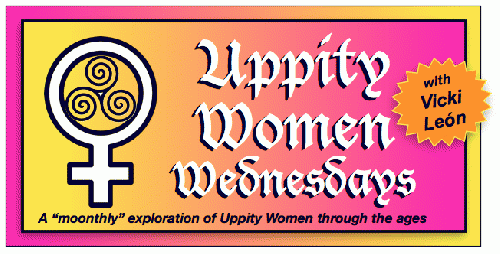Number Four in the monthly Uppity Women Wednesday Series, started in April, 2014.
Imagine watching unwilling females of your acquaintance being strip searched, probed, and tortured by a group of your friends, from needle stabbing to the very public, pubic shaving of said naked ladies. Sound like a tall tale from the internet? Far from it. These abuses were routinely carried out by numerous holier-than-thou religious communities of colonial America.
All in the sacred name of witchcraft suppression.
Nowadays, we don't get very excited about witches, much less fear them. Instead, we regard broomhildas as movie stereotypes; as figures of fun; or as sexy choices for Hallowe'en dress-up. But for seven shocking centuries in Europe and in colonial America, it was a much darker story.
As late as the mid-19th century, people implicitly believed in witches. Men and women, rich and poor, Catholic and Protestant, educated and unlettered, stoutly swore that witchcraft existed. They saw sorcery as Satan, who took his victims unawares and overwhelmed them. Furthermore, as churchgoers, they believed they had a Christian duty to hunt down witches and eradicate them.
Influential preachers from John Wesley to Cotton Mather reinforced that view, citing the Bible and The Devil's Hammer, a witch-hunter's manual published in 1484. The ultimate how-to book, written by a pair of inquisitors and endorsed by the pope, its timing was perfect. The pope had already blamed Europe's freezing weather and crop failures (we now call that period the Little Ice Age) on witches and magicians. Thanks to Gutenberg, who in 1450 invented the printing press, The Devil's Hammer became one of history's first printed bestsellers. It maintained its influence clear into colonial times and throughout the early American colonies.
In one sense, this all-too-intense belief in the supernatural was convenient. As humans, throughout our lives we encounter inexplicable events, weird mischances, and tragedies, from job loss to miscarriages. We try to make sense of them; failing that, to accept them. But in those bygone days, rational thought was rare. Instead, there existed real phobias about the devil and magic; along with a deep fear of women and what the Devil's Hammer authors referred to as their "voracious carnal appetites."
On the pages of that book, the authors told lurid tales of women who had sex with a variety of demons. They "documented" the shameless hussies and crones who stole men's penises, a sure signal of witch behavior. This mindset connected powerfully with males, who liked to imagine themselves as superior to women. At the same time, these fearful stories enabled men to easily blame often-powerless females as scapegoats.
We tend to think of the Salem hysteria of 1692 and 1693 as America's first and only witch persecution. Not so. Fifty years earlier, the devoutly Puritan government of Connecticut made "witchcraft" one of its twelve capital crimes. In May of 1647, Alse Young of Windsor, the first person executed for witchcraft in colonial America, was hanged on the site where the Old State House now stands. Sorcery hysteria had reared its ugly head in Hartford and two other communities. Some 46 trials took place; eleven persons, almost all women, were sent to the gallows.
(Note: You can view every article as one long page if you sign up as an Advocate Member, or higher).





